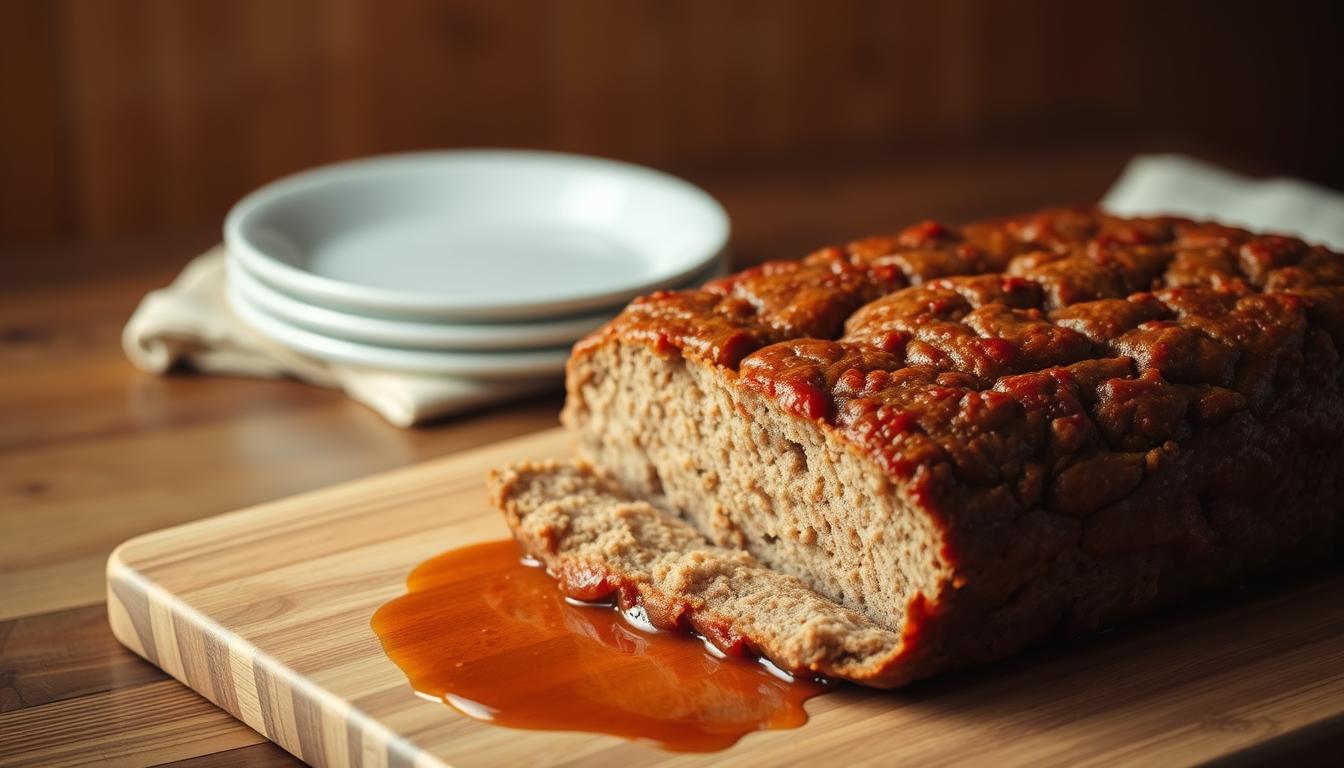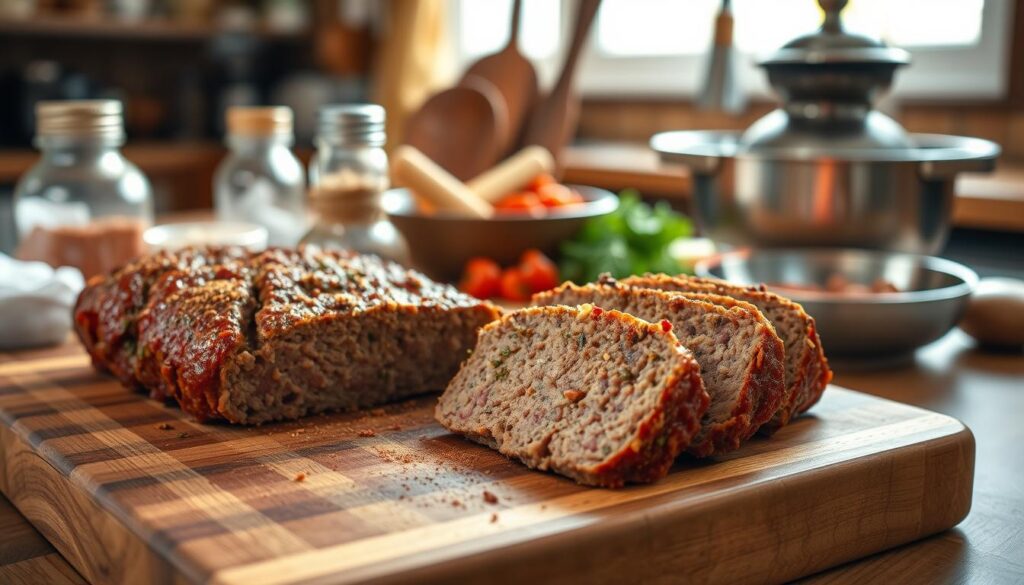
There’s something truly special about a homemade meatloaf that brings people together. For years, my family’s secret recipe has been a staple at our gatherings, and it’s become a favorite among my blog readers too. What makes this homemade meatloaf stand out? It’s not just the perfect blend of flavors—it’s the ease of preparation and that irresistible sweet and tangy glaze that keeps everyone coming back for more.
Creating a moist and flavorful meatloaf doesn’t have to be complicated. This recipe is designed to be straightforward, ensuring your loaf turns out tender and juicy every time. Whether you’re a seasoned cook or just starting out, these tips and tricks will guide you through making a meatloaf that’s sure to impress.
In this detailed guide, I’ll walk you through everything from selecting the right ingredients to storing your finished masterpiece. By the end, you’ll have all the tools you need to make a homemade meatloaf that’s nothing short of perfection.
Key Takeaways
- Discover the secret to a moist and flavorful homemade meatloaf.
- Learn how to create a sweet and tangy glaze that elevates your dish.
- Get tips for ensuring your meatloaf turns out tender and juicy.
- Explore easy storage methods to keep your meatloaf fresh.
- Follow a simple, step-by-step guide for perfect results every time.
Introduction to My Homemade Meatloaf Journey
My love affair with meatloaf began in a way I never expected. Growing up, I was always a bit skeptical of this classic dish, but one fateful evening, everything changed. My family gathered around the dinner table, and there it was—this beautifully glazed, golden-brown loaf that instantly captured my curiosity. That first bite was a revelation, and it laid the foundation for what would become a cherished family tradition.
My First Encounter with Meatloaf
I remember it vividly. My mom had spent hours in the kitchen, the aroma of sautéed onions and garlic filling the air. When she brought out the meatloaf, I was hesitant, but one bite changed everything. The combination of tender ground beef, the subtle crunch of onions, and that sweet, tangy glaze was nothing short of magical. It was more than just a meal; it was a comfort that brought us all together.
Why I’m Excited to Share This Recipe
Over the years, I’ve perfected this recipe, tweaking ingredients and techniques to make it my own. Every step, from mixing the ingredients in a bowl to letting it rest before slicing, has been thoughtfully refined. It’s a dish that’s not just about flavor but about the memories it creates. Sharing this recipe feels like passing on a piece of my family’s history, and I’m excited for you to experience the same joy it’s brought me.
Essential Ingredients for a Perfect Meatloaf
The right ingredients are the backbone of a delicious homemade meatloaf. Each component plays a vital role in creating that perfect balance of flavor and texture.
Selecting the Best Ground Beef and Other Meats
When it comes to ground beef, I always opt for 80/20 or 85/15 lean to fat ratio. This ensures the meatloaf stays juicy without being greasy. If you prefer a leaner option, ground turkey or pork can be great substitutes. Just keep in mind that leaner meats might require a bit more milk to retain moisture.
Fresh Aromatics and Seasonings That Make a Difference
Fresh onions and garlic are essential for building a robust flavor profile. I recommend finely chopping onions and sautéing them until translucent before mixing them in. This softens their texture and enhances their sweetness. Garlic should be minced and lightly sautéed to bring out its aroma without overpowering the dish.
Breadcrumbs and milk are key to a tender texture. I use panko breadcrumbs because they absorb moisture without making the meatloaf dense. Adding a cup of milk soaked into the breadcrumbs ensures the loaf stays moist. For binding, an egg is a must, and I always season with salt, pepper, and a sprinkle of Italian seasoning for depth.
The glaze is where the magic happens. A mixture of ketchup, brown sugar, and a tablespoon of your favorite sauce creates a sweet and tangy topping. I brush this glaze on during the last 15 minutes of baking to give it that caramelized finish.
Step-by-Step Meatloaf Recipe Process
Creating a delicious homemade meatloaf is easier than you think. Follow these simple steps to ensure your dish turns out perfectly every time.
Prepping the Ingredients
Start by preheating your oven to 350°F. Line a baking sheet with parchment paper for easy cleanup. While the oven is warming up, sauté chopped onions in a little oil until they’re soft and golden brown. This step adds a depth of flavor you won’t want to skip.
Mixing and Shaping the Loaf
In a large bowl, combine your ground meat, sautéed onions, egg, breadcrumbs, and seasonings. Mix everything together with your hands or disposable gloves until just combined—remember, overmixing can make the loaf tough. Shape the mixture into a loaf form, about 9×5 inches, and place it on the prepared baking sheet.
| Step | Action | Time |
|---|---|---|
| 1 | Bake without glaze | 30 minutes |
| 2 | Apply glaze | 15 minutes |
| 3 | Check doneness | 5 minutes |
Bake the loaf for 30 minutes, then brush on your glaze. Return it to the oven for another 15 minutes. Use a thermometer to check for an internal temperature of 160°F. Let it rest for a few minutes before slicing and serving.
Creative Variations and Substitutions
One of the best things about this recipe is its versatility. Whether you’re looking for a healthier option or just want to mix things up, there are plenty of ways to get creative with your ground meat.
Using Alternative Proteins Like Turkey or Pork
If you want to try something different, consider swapping ground beef with ground turkey or pork. These alternatives can add unique flavors while keeping your meatloaf juicy. For a leaner option, ground turkey works well, but you might need a bit more milk to keep it moist. Pork, on the other hand, adds a rich, savory taste and a slightly firmer texture.
| Protein | Cooking Time | Texture |
|---|---|---|
| Ground Beef | 45 minutes | Tender and juicy |
| Ground Turkey | 40 minutes | Leaner, slightly drier |
| Ground Pork | 50 minutes | Rich and firm |
Remember, no matter which protein you choose, the key to a great meatloaf is using the right breadcrumbs and an egg to bind everything together. These small details ensure your loaf stays flavorful and moist every time.
Tips and Tricks for a Juicy and Flavorful Meatloaf
When it comes to crafting the perfect meatloaf, it’s all about the little details that make a big difference. These insider tips will help you achieve a dish that’s both flavorful and moist.
Avoiding Overmixing for Optimal Texture
One of the biggest mistakes people make is overmixing the ingredients. Mix everything just until combined—any more, and you’ll end up with a dense loaf. I like to use a gentle folding technique to preserve the texture of the meat and breadcrumbs. This ensures your meatloaf stays tender and juicy.
The Art of Sautéing Onions and Garlic
Sautéing onions and garlic is an essential step that shouldn’t be rushed. Cook the onions until they’re translucent and lightly caramelized, then add in minced garlic for just a minute to avoid bitterness. This method not only enhances the flavor but also minimizes those pesky “onion burps.”
For an extra touch, balance the fat content by choosing the right ground meat. A higher fat percentage keeps it juicy, while a leaner option might need a splash more milk. Don’t forget a sprinkle of sugar in the glaze—it caramelizes beautifully and adds depth to the flavor. Trust me, these small tweaks will make your meatloaf a crowd-pleaser every time!

How to Bake Meatloaf: Techniques and Tools
Baking a homemade meatloaf requires more than just tossing it in the oven. The right techniques and tools can make all the difference in achieving that perfect crust and texture. Let’s dive into the best methods for baking your loaf to perfection.
Baking Sheet vs. Loaf Pan: Which is Better?
Choosing between a baking sheet and a loaf pan can be tricky. A baking sheet allows for better airflow, giving your meatloaf crisper edges. On the other hand, a loaf pan keeps the loaf moist by trapping juices, but it can sometimes lead to a less desirable crust. Here’s a breakdown of the pros and cons:
| Tool | Pros | Cons |
|---|---|---|
| Baking Sheet | Crispy edges, better airflow, easy cleanup | Can dry out if overcooked |
| Loaf Pan | Retains moisture, uniform shape | Softer crust, harder cleanup |
For a crisper crust, opt for a baking sheet. If moisture is your top priority, a loaf pan is the way to go.
Preheating and Prep Tips
Preheat your oven to 350°F for even cooking. Line your baking sheet with parchment paper or lightly grease your loaf pan to prevent sticking. Proper prep ensures your meatloaf bakes evenly and the glaze caramelizes perfectly.
Adjusting Time and Temperature
Baking time varies by pan. A baking sheet might need 35-40 minutes, while a loaf pan could take 45-50 minutes. Always check with a thermometer for an internal temperature of 160°F. This ensures your meatloaf is cooked to safety without drying out.
In conclusion, whether you prefer a crispy crust or a moist texture, the right tools and techniques will elevate your meatloaf game. Choose your pan wisely and follow these tips for a delicious, perfectly baked loaf every time.
Preparing and Storing Your Meatloaf
Preparing and storing your homemade meatloaf properly ensures it stays fresh and flavorful for days to come. Whether you’re making it ahead of time or storing leftovers, these tips will help you maintain its quality.
Making Ahead and Refrigeration Strategies
You can assemble the meatloaf mixture a day in advance. Simply mix all ingredients in a bowl, cover it with plastic wrap, and refrigerate. Let it sit at room temperature for 30 minutes before baking to ensure even cooking. For leftovers, store them in an airtight container in the fridge for up to 5 days. Reheat slices in the oven at 300°F for 10-15 minutes or in the microwave until warmed through.
Freezing Raw Versus Cooked Meatloaf
Freezing is a great way to extend shelf life. For raw meatloaf, shape it on a baking sheet, wrap tightly in plastic wrap, and place in a freezer-safe bag. Cooked meatloaf can be sliced, wrapped individually, and frozen for up to 3 months. Thaw frozen raw meatloaf overnight in the fridge before baking, and reheat cooked slices in the oven or microwave until steaming hot.
| Method | Storage Time | Reheating |
|---|---|---|
| Raw | Up to 3 months | Oven: 350°F for 45 minutes |
| Cooked | Up to 3 months | Oven: 300°F for 15 minutes |
| Leftover | Up to 5 days | Microwave: 30-45 seconds |
Always label and date your stored meatloaf for easy tracking. Proper storage ensures your dish remains moist and flavorful, whether enjoyed fresh or reheated later.
Why Meatloaf is My Go-To Comfort Food
Meatloaf holds a special place in my heart, and it’s more than just a meal—it’s a tradition that brings warmth and comfort to my family. There’s something about the aroma of ground beef, onions, and spices baking in the oven that feels like home. Every time I make meatloaf, I’m reminded of the love and care that goes into creating a dish that’s both nourishing and delicious.
The blend of ingredients is what makes this food truly special. The combination of beef, sautéed onions, and a hint of sweetness in the glaze creates a flavor profile that’s hard to resist. It’s not just about the ingredient list; it’s about the time and effort put into mixing, shaping, and baking the loaf to perfection.
For me, meatloaf is about tradition and the memories we create in the kitchen. Every batch is crafted with care, ensuring that each slice carries the same love and warmth as the first. It’s a dish that never fails to bring comfort and joy, making it my go-to choice for family dinners and special occasions alike.
Pairing Meatloaf with Perfect Sides for a Complete Meal
When it comes to creating a well-rounded dinner, the right side dishes can elevate your homemade meatloaf to new heights. The key is to balance rich flavors with fresh, complementary textures that enhance the overall dining experience.
Creamy Mashed Potatoes and Roasted Vegetables
Creamy mashed potatoes are a classic choice that pairs beautifully with meatloaf. They provide a hearty contrast to the savory loaf. To make them extra special, I recommend adding a sprinkle of garlic powder and a pat of butter for a luxurious touch. Roasted vegetables, such as broccoli or Brussels sprouts, also complement the dish nicely. Toss them in olive oil, season with salt and pepper, and roast until tender and caramelized.
For a well-rounded meal, consider adding a fresh salad or a slice of warm bread. A crisp green salad with a light vinaigrette cuts the richness, while a warm loaf of bread soaks up the juices perfectly. These additions create a balanced and satisfying meal.
Here are some tips for pairing:
- Portion sizes: Aim for about a cup of mashed potatoes and a cup of roasted vegetables per serving for a filling yet balanced meal.
- Enhance sides: Add a sprinkle of Parmesan cheese to your mashed potatoes or toss roasted vegetables with fresh herbs like rosemary for extra flavor.
By thoughtfully selecting your sides, you can create a meal that’s not only delicious but also visually appealing. The combination of flavors and textures will make your homemade meatloaf the star of the dinner table.
Conclusion
Bringing it all together, this homemade meatloaf recipe is a testament to simplicity and flavor. By following the detailed instructions and tips shared throughout this guide, you’ll create a dish that’s both moist and delicious. Whether you’re a novice in the kitchen or a seasoned cook, this recipe offers a perfect balance of nutrition and taste.
One of the key tips for success is avoiding overmixing, which ensures a tender texture. Don’t forget to let the loaf rest after baking—it makes all the difference. With a preparation time of just 30 minutes, this food is perfect for busy days.
This meatloaf isn’t just about nutrition; it’s about creating memories. Feel free to experiment with different ingredients while keeping the core instructions intact. It’s a versatile dish that adapts to your preferences, ensuring every bite is satisfying and wholesome.
I hope you’ve enjoyed this journey through my family’s cherished recipe. It’s a dish that’s close to my heart, and I’m thrilled to share it with you. I’d love to hear your thoughts and any creative twists you try! Happy cooking, and let’s make every meal a memorable one.
